597
Señor paella or what we don't know about Spanish paella
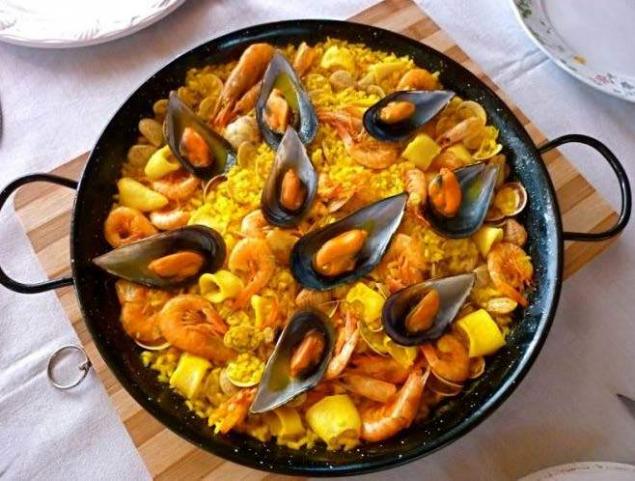
For foreigners Spanish paella is one of the symbols of this country, the same as flamenco or bullfighting. When it comes to the cuisine of Spain, then perhaps this dish will come to mind first. But this is a view from the side. How are paella Spaniards? Like the Italians — pasta: there are lots of lovely dishes, but it is paella. And it's serious. The Spaniards are willing to argue themselves hoarse about new recipes and ways of cooking this dish and complain that paella "obespechivaetsya", spreading around the world. Frozen semi-finished product for the microwave? It is absolutely impossible! Paella is considered a national asset that should be stored carefully...

Actually, paella is not a dish, it's a whole group of dishes, which unites except the rice, olive oil and saffron. And, of course, the method of cooking rice. It is considered that there are over three hundred different recipes for paella. In reality, there are many more – like every Russian housewife has secret borscht recipe, inherited from her grandmother and from Spanish macho (a paella is traditionally cooked by men) has its own culinary secret.
And this dish is not Spanish! It – Valencia, and is recognized even by residents of other regions. The Arabs, for centuries owned the Iberian Peninsula, instilled in the locals culture of rice growing and rosedene. The climate of Valencia is better suited for cultivation of rice, and paella and appeared here.

Of course, in this respect there are several different legends. The legend is "romantic" tells the story of the fisherman, cortalim time waiting sweetheart, " he mixed everything found in the kitchen, and filled with rice. Beloved culinary results of the experiment appreciated!

Legend "historic" talks about how to Valencia came some important person (options: Roman Emperor, Spanish king, Bishop and so on – until Napoleon!) To show hospitality and glory to entertain the visitor, the people gathered all their supplies and prepared a new dish.
"Practical" legend says that paella was invented by the Christian servants of the Moorish rulers, bringing home the remains of the master's feasts, or poor fishermen, connecting with rice residues catches.
The true time of occurrence of the paella is unknown, but in Spanish cookbooks it appears from the XVIII century.
These days paella can be ordered in almost every restaurant in Spain, but, unfortunately, the tasty dish is not easy to find – proven on our own experience! The influx of different tourists who decided to join the "authentic Spanish cuisine", led to the fact that restaurant owners began openly moonlight. Alas, too often under the guise of paella will be served "undercooked risotto, where the rice is either too hard, or – like porridge, gruel, chicken will be the sole and mussel shells will be empty...
Some councils wishing to avoid such disappointment.
Where and when is? Universal rule – do not order this dish at the beach restaurants and close to popular tourist attractions! And certainly do not take the paella in the "menu del dia" — you bring a dish in a few minutes, which can only mean one thing-made it long ago, and you just warmed up... And in General the farther you go away from tourist areas, the more chances to try authentic paella. Be careful: in the traditional restaurant, the paella is never served for dinner is a daily dish. And it is not accepted to cook for one – so to taste the paella is better in the company. For many years the traditional "pelnym day" in Spain was on Thursday, when the dish is prepared in all the local "gastronomy". Explain it in different ways. Someone says that it's all gone since the weekend when the Spanish maid was just Thursday, so this day the family dined outside the home. And some believe that the fishermen leaving on Monday, back on Wednesday, and the next day to the restaurants received a fresh catch.
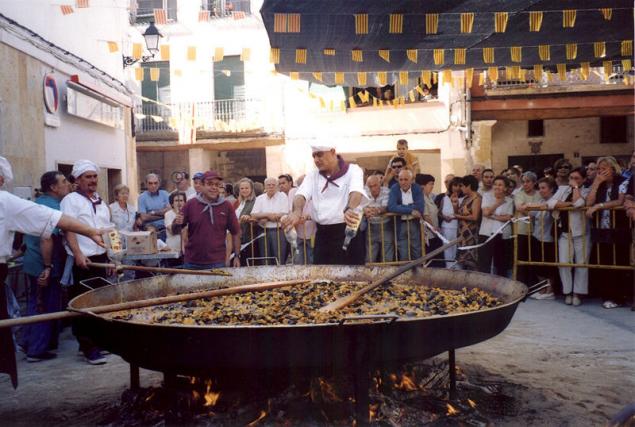
And on Sunday made the paella to cook at home. Outdoors on an open fire – for the whole family and friends, cooking and turning food into a feast. It is believed that joint eating paella unites and brings together. Willing to believe – not to argue for a delicious, lovingly prepared food? Best of all, of course, to try paella that's right... At the great feasts is cooked on the entire campus – on the giant pans to at all enough. The Valencian region is a mandatory part of the celebration of the feast of St. Joseph (March 19) is cooking a huge paella. And in 2001, near Madrid took a giant paella for 100,000 people!
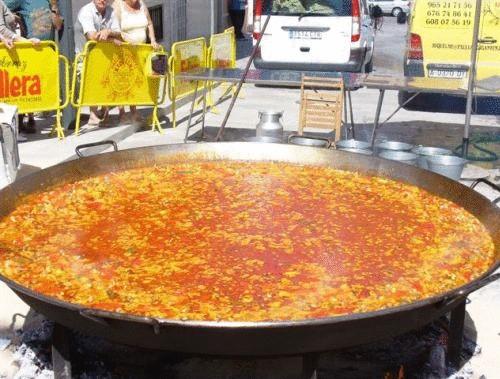
How and what to eat?
The simple answer to this question – with pleasure (if the paella is good, of course)! However, there are some subtleties, which I want to tell.
There are two ways of filing paella – traditional and modern.
According to the classics, paella is eaten directly from the pan, all together – everyone from your "sector". Very traditional wooden spoons, as (according to culinary purists) metal utensils will spoil the taste. But in our days, tend to serve and plates and Cutlery. Uncleaned mussels decided to postpone on the edge of your plate or frying pan, and eat it at the end with your hands. It is also permissible with your hands to separate the chicken meat from the bones. There is also a "lazy paella" (for the lazy eaters, not cooks), where all the seafood is pre-cleaned. Another rule is to be sure to eat the "burnt" rice crust (it's called "socarrat") at the bottom of the pan. To leave her is to offend the cook not appreciate the dish!
To wash down the paella made with dry wine, depending on the type of meals it can be white, red and pink. But not sangria! In "proper" restaurants serving paella, sangria even the menu is not present!
What kind of paella to choose? This is probably the most difficult question... As I said, the types of this dish are many.
In the composition of the meat paella (paella de carne) may include chicken, duck, rabbit, pork, ham and even spicy chorizo sausage and sausages. Beef and mutton in the part of paella I personally have never met, but we can assume that somewhere these types of meat used. Sometimes add a hard-boiled egg. Preparing a paella as water and broth.

Seafood paella (paella marinera or paella de marisco)is composed of shrimp and squid of different sizes, octopus, cuttlefish, mussels and other shells. Meet and fine crayfish, lobsters, crabs. The Valencian paella (paella valenciana) put the snails. Often the seafood combination with fish of different types, there are pure fish options — paella de pescado. To prepare these kinds of paella on the water, fish broth and dry white wine. A special kind of paella is called "black rice" (arroz negro) — it is prepared with cuttlefish ink which color the dish.

The choice of vegetables for the paella is very wide – you can use bell peppers, zucchini, artichokes, asparagus, beans, carrots, green peas, olives and even mushrooms. Tomatoes – a must! And what about onions and garlic disputes — as the zealous advocates of the use of these vegetables and hot opponents... Vegetables in various combinations can enter into any kind of paella, but there are also purely vegetarian versions of dishes (paella de verduras, or paella vegetariana). From spices and seasonings mandatory salt (preferably large sea) and saffron (only natural!) around the stamen per serving. Often paella, flavored paprika powder and rosemary. And the finished dish is usually served with lemon.

The most famous mixed paella (paella mixta), which often offer tourists. The familiar combination of chicken and seafood with vegetables, although you can find more exotic options. The main debate about the paella just concern what and what is permissible to mix. As elsewhere, there are "conservatives" behind the traditional combinations of products, and "innovators", who are for the freedom of creativity. Generally this dish is a Paradise for lovers of culinary experiments. Variants of paella so much that the "real" or "correct" does not exist! There are only tasty and tasteless... to come up with their paella – what could be more fun?

So how do you cook paella? Despite the space for culinary imagination, there are several rules that must be followed, what kind of paella you cook.
First of all, choose the dishes. We need a wide and shallow pan with two handles called paellera or paella (the dish got its name from her, and not Vice versa!) Its diameter varies from 20 cm to a meter. Because the layer of rice should not exceed two centimeters, the diameter is calculated by number of consumers. The best are cast-iron paellera for cleaning never use detergents.


It is very important to keep baked dish is uniformly heated. I was struck by how seriously to that the Spaniards – even sold special gas burner is required in order that the flame was the same under all paelleras. If the dish is the highlight of the picnic and prepared on open fire, the fire is constantly monitored, and the wood chosen carefully and long. Considered ideal dry vine and orange tree, but it's a foodie tales...


The hardest part of paella making – in time to catch the moment when the rice has reached the right consistency – soft enough, but not overcooked. While cooking (especially there is no experience) necessary to increase the fire, pour water or broth, and in the end you need a few minutes to make the heating very strong – to form the "crust". And remember, paella is not stirred! Before serving the paella "piping hot" I leave for a few minutes so the rice completely "reach condition".
The best rice for paella – Valencia (many varieties — for example, bomba or bahia). But it will fit any round (not steamed and not flavored) which absorbs the liquid. Rice for paella do not wash out!

And now, when General recommendations all clear, let me offer you a few recipes. I collected them for years in different regions of Spain (the recipes were given to me by neighbors, friends and even restaurateurs), translated tips from cookery books and Spanish sites, tried, combined and processed... it is paella – it works! The result is something perfect for me and my household. All recipes are for 4-5 servings and the pan 40 cm in diameter. (In Moscow the kitchen have to cook on two pans of a smaller size, like size of the burner to the appliance).
Paella in Valencia
- 1 small chicken (1 kg)
- 0.5 kg duck (better feet) or 0.5 kg of the rabbit
- 15-20 PCs of snails (I used already cooked, but the shells)
- 0.3 kg of rice
- 2-3 cloves of garlic
- 1 large tomato
- 0.3 kg of green beans
- 0.2 kg white beans (pre-soaked or boiled)
- Saffron (grind 4-5 stamens), 1 tsp ground paprika, salt to taste, rosemary
- Olive oil

Fry the garlic in large quantities of olive oil, remove from paellera. In the same oil until Golden brown stir-fry the meat, together with bones chopped into pieces 3-5 cm Add green beans, white beans, fry. Add the peeled and chopped tomato, escargot, salt, paprika, saffron and a sprig of rosemary. Add water (approx 1 litre) and simmer for 15 - 20 minutes. When the water evaporates in half, pull out the rosemary, add rice and spread it on the pan. Do not disturb! The first 10 minutes of cooking on high heat, then reduce the heat and cook for another 7-10 minutes. When the rice absorbs almost all the water, dramatically increase the fire – literally 1 minute. So notorious and formed a crust. Remove from heat, cover with a towel (Spanish – honest! — use newspaper) and let stand for 5 minutes. Serve with sliced lemon quarters.
PS If anyone is confused by the snails, then you can perfectly do without them!
Paella with seafood
For it will need:
- Large shrimps -15-20 is Better to use untreated, or at least with tails
- Squid – 2 medium
- Mussels (in shells) – 15-20 pieces If you are using mussels without shells, then take them a little more
- Octopus –4-5 small or 2 medium
- Scallops – 0.2 kg
- 0.3 kg of rice
- 2-3 cloves of garlic
- 2 tomatoes
- Saffron (grind 4-5 stamens), 1 tsp ground paprika, salt to taste
- 0.5 liters of dry white wine
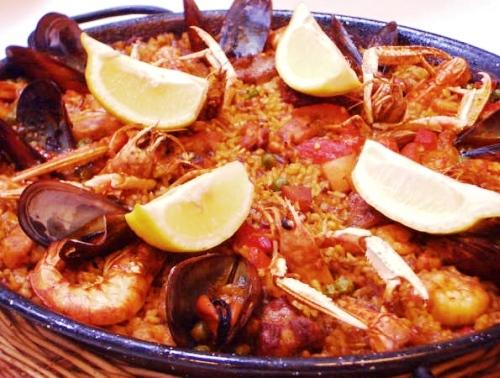
The principle of the preparation is almost the same as in the previous recipe. So just a few words about the order of bookmarks products. First, fry the prawns and scallops, remove from the pan. They will need to return to the dish at the very end of cooking. The rest of the seafood stew with tomatoes and spices in white wine, then add water, bring it to a boil and add rice.
P. S. in the absence of fresh seafood, you can use frozen. The taste is certainly different, but it works – tested! Before preparing them better to defrost slowly in the fridge, drain the water and dry. Seafood can take any and in any combination.
Before I get to the third recipe, let you a little history. A dish called "arroz a banda" (something like "rice separately) I ordered in the tiny restaurant, whose owner became friends only after long and persistent coaxing, and – not to offend a good man. Well, what interest is there empty pic when you can add many great ingredients?!!! So much I did not mistake for a long time – brought me a dish was not just tasty... It was a masterpiece! What I cook at home, using kindly given me the recipe, the masterpiece is not pulled. But it was tasty. I hope that next time will go better – I will try. You can also try this.
First of all, you need to weld a strong rich soup of fish and seafood. You can use any varieties of fish (bones, heads, tails and fins are also used), and any "marine reptiles". In addition to the salt, the broth flavored with rosemary, thyme, Bay leaf and black pepper (peas). The broth drain, but the remaining small pieces of fish or shrimp is allowed.
500 grams of rice we will need a liter of broth, a couple cloves of garlic, 1 onion, 2 tomatoes, olive oil and, of course, saffron.
Chopped garlic fry in olive oil (this time leave it in paellera!), add chopped onion and bake it until Golden brown. Then put mashed tomatoes without peel and saffron. Pour the broth, bring to a boil, place the rice. Further — still, as with any paella. Serve this rice with lemon and Aioli sauce.
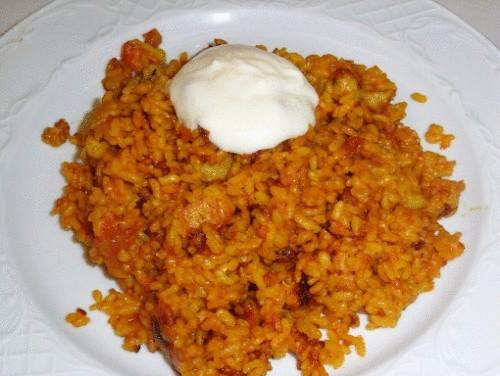
Source: www.liveinternet.ru/users/marusya_esk/post285280145
Gorgeous design of a conventional house
Advertising in the metro – the most powerful engine of Commerce























